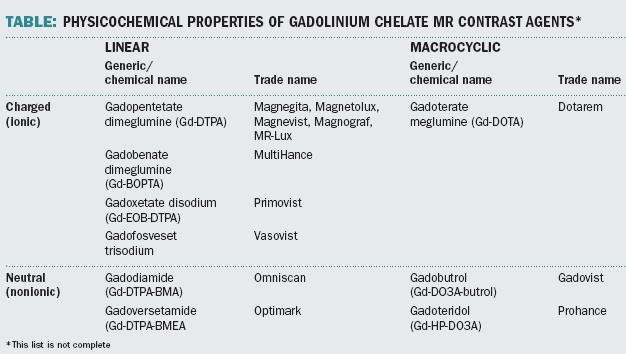MR contrast agents vary in chelate power
Clinical low-molecular-weight paramagnetic contrast agents distribute into the intravascular and extracellular fluid space of the body.
Clinical low-molecular-weight paramagnetic contrast agents distribute into the intravascular and extracellular fluid space of the body. They are water-soluble and not tissue specific. The majority do not bind to protein. Their contrast-enhancing effect in MR imaging is caused by the metal ion in their center that contains unpaired electrons. It depends on dose and/or magnetic field strength.
At present, paramagnetic gadolinium-based contrast agents are the most frequently used compounds in MRI. With its seven unpaired electrons and relatively long electron-spin relaxation time, gadolinium possesses the greatest ability to alter the relaxation times of adjacent protons (the highest relaxivities r1 and r2).
Because the gadolinium ion is rather toxic, it has to be bound in stable complexes in which it is assumedly kept until the contrast agent is excreted. This binding organic molecule acting is called a chelator, after the Greek word for claw. The bond should be as tight as possible to counteract the lability of the compound and to prevent the release of “free” gadolinium into the human body.

Among these chelators are DTPA, DTPA-BMA, DTPA-BMEA, DOTA, DO3A-butrol, and HP-DO3A. Bound to them, gadolinium forms low-molecular-weight water-soluble complexes, the contrast agents, which are excreted through the kidneys. Gd-DTPA and Gd-DOTA are called ionic agents, whereas Gd-DTPA-BMA, Gd-DTPA-BMEA, Gd-DO3A-butrol, and Gd-HP-DO3A are called nonionic. In this context, the terms “globally charged” and “globally neutral” would be better.
Their effect on T1 and T2 is similar, but since T1 of tissues is much higher than T2, the predominant effect at low doses is that of T1 shortening. Thus, tissues taking up such agents will become bright in a T1-weighted sequence.1
Further compounds include gadolinium bound to BOPTA, EOB-DTPA, and similar ligands that are slightly more lipophilic and excreted via the kidney but also via the liver. The relaxivities of such compounds can be higher because they may bind to protein.
Chelates come as stretched, or linear, or cyclic or macrocyclic molecules. In the early days of research and development of these contrast agents, their feared toxicity was associated with the possible competition with endogenous ions such as zinc and calcium. Such an exchange, called transmetalation, frees gadolinium from the chelate into the body. When dissolved in water, all commercially available complexes are very stable. Only one molecule over several millions or billions releases its gadolinium. When in the body, however, challenged by other ions that want to replace the gadolinium, these molecules behave differently.
Gadolinium ions carry three positive charges. If the chelator brings three negative charges (as in Omniscan, ProHance, Gadovist, and Optimark), the global charge is zero (globally neutral). If it brings more (as in Dotarem, Magnevist, MultiHance, and Vasovist), the global charge is negative (globally charged).
This is not the key to stability, however, since the macrocyclic structures are the most stable regardless of their charged (Dotarem) or neutral (ProHance and Gadovist) character. For the other contrast agents, the so-called open-chain chelates (Omniscan, Magnevist, MultiHance, Vasovist, and Optimark), the situation is clearly different: Simple analytical tests show that their ability to retain their gadolinium ion is weaker.
It has been shown, however, that, submitted to the same tests, the negatively charged Magnevist, MultiHance, Vasovist, and Optimark are more stable than the neutral Omniscan. In addition, branching the organic backbone of the chelate increases the stability of the former ones.2-6
Thus, from a chemical point of view, certain agents are to be preferred over others.
Editor's note: In the November issue we carried a commentary from Prof. Rinck exploring some of the political, economic, and ethical issues in the controversy over gadolinium contrast and nephrogenic systemic fibrosis. This column looks at some of the technical issues.
Study: Monitoring of Prostate MRI Exams Could Lead to 75 Percent Reduction of Gadolinium Contrast
March 17th 2025While DCE MRI was deemed helpful in over 67 percent of cases in which it was used, researchers found that monitored prostate MRI exams, which facilitated a 75 percent reduction of DCE MRI sequences, had comparable sensitivity for prostate cancer as non-monitored exams.